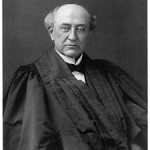At all most every law school founded before 1960, a story is told about a past dean who addressed incoming classes by telling them: “Look to your left and then to your right, and three years from now, only one of you will still be here.” The softer version of the story ended “and only two of you will still be here.”
The story is probably apocryphal in its origins, although it was certainly used by later deans to emphasize the difficulty of legal study. Today, the story is usually told to illustrate how lax legal education has become in the modern era.
To the extent that that this story reflects past reality, it is actually a commentary on how easy it was to get into most American law schools before the great surge in applications that began around 1970. Even Harvard Law School did not reject a qualified applicant until 1939 (although it is true that Harvard had stiffer entrance requirements than most law schools in the first half of the twentieth century.)
Most law schools accepted all applicants who met their minimum entry requirements and then let the chips fall. Those who could handle the work continued to graduation. Those who couldn’t either flunked out or dropped out.
History does not record whether Dean Max Schoetz delivered the “look to your left” speech when he greeted the entering class at the Marquette Law School in the fall of 1919. But if it did, and had he used the softer version of the story, his prediction would have been borne out by subsequent events. There were 92 students enrolled in the first post-World War I day division entering class, and only 66 made it to the second year. One of those who did not was Milwaukee native Pat O’Brien, who later became famous as a Hollywood actor (e.g., The Front Page, The Knute Rockne Story).
Whether O’Brien and the other 26 students who didn’t continue on for a second year flunked out or merely decided to pursue a different path in life is difficult to determine. To remain eligible to continue, students had to pass more than half their courses, and 70 constituted a passing grade.
Admission requirements for the law school in 1919 were fairly modest. Ordinarily a student had to be a high school graduate and have attended college for one year. However, if an applicant was a high school graduate who had not yet attended college, he or she was allowed to enroll in a four-year program at the law school in which most second-year courses were taken in the college—essentially to meet the one year of college requirement. This turned out to be a popular alternative, particularly for veterans like O’Brien who were anxious to get on with their careers. Twenty-nine of the 66 students who entered the day program in the fall of 1919 and continued on for a second year were admitted under this option. Students who were not high school graduates could opt to take a special examination, and if they passed it they were admitted as well. Anyone could enroll in the four-year night program whether or not they had finished high school, and 63 individuals did. The total first year enrollment of 155 in the fall of 1919 was the largest in the school’s history.
Under a recent change necessitated by Association of American Law School guidelines, night students were not eligible to receive a law degree from Marquette beginning with the 1919-1920 academic year, but their attendance did qualify them to take the Wisconsin bar exam. The diploma privilege had not yet been extended to Marquette, so all its law students were required to pass the bar exam before they could begin law practice. Wisconsin also required that applicants for admission to the bar have completed a high school course or its equivalent, and a few evening students were attending law school and high school at the same time.
Only four students in the day division and only one in the night group were listed as holding college degrees prior to beginning law school. Most of the students, day or night, hailed from Wisconsin. Only 11 of 92 first-year day students are listed in the Law School Bulletin as being from outside Wisconsin, and except for a single student from Montana, the others were all from the Midwest: Illinois (3), Iowa (3), Minnesota (2), and Michigan (2). Only three of the 92 were female.
Ironically, the night division (known as the “Owls”) was geographically a slightly more diverse group. Out-of-state students accounted for 13 percent of the night class, just ahead of the 12 percent for the day division. While there were also students from Minnesota (2), the night class featured individual students from the more distant venues of Ohio, South Dakota, Montana, New Hampshire, Virginia, and the Philippines. Two of the evening students were female and one, Edward Snyder, was a medical doctor.
Attrition was even higher among the ranks of the night class with only 39 of the 63 night students returning for a second year. Among those not returning were most of the out-of-state students and Dr. Snyder.
In the aftermath of World War I, which had disrupted the vocational plans of so many American men, the law school appeared to be reluctant to impose barriers in the way of anyone who wanted to become a lawyer. However, it did not appear to be willing to carry along students who were unable or unwilling to meet its academic standards. It is worth remembering, however, that law school education was not a prerequisite for bar admission in Wisconsin (and most states) in the early 1920’s. Those who left law school were free to enter apprenticeship arrangements and qualify for the bar that way. (In fact, they could still count their unsuccessful law school year or years toward the state’s three- year “law study” requirement.)
The following is the curriculum in effect for first-year day students during the 1919-1920 academic year. The number in parentheses is the number of hourly meetings each week for that particular course.
FALL
The Study of Cases (1)
Criminal Law (2)
Criminal Procedure (1)
Contracts I (3)
Torts I (2)
Personal Property (2)
Common Law Pleading I (1)
Natural Law (1)
Total Hours: 13
SPRING
Contracts II (3)
Torts II (2)
Common Law Pleading II (2)
Agency (2)
Equity (2)
Real Property I (1)
Natural Law II (1)
Legal Bibliography (1)
Total Hours: 14.
The Natural Law course was taught by the university president, Rev. Herbert Noonan; Personal Property and Legal Bibliography were taught by Dean Schoetz.
Each course had a written examination at the end of the term, which meant that full-time day-division students took 15 exams during their first year of law school, seven in fall and eight in the spring. Students in the 4-year program — those who lacked prior college credits — took year-long courses in English and Argumentation in lieu of Contracts I & II, Criminal Procedure, Personal Property, Agency, and Equity.
 My article, Constitutional Safety Valve: The Privileges or Immunities Clause and Status Regimes in a Federalist System (previously mentioned here and commented on here), is finally out in the current issue of the Alabama Law Review. (Pre-publication version here.) This article represents the end point of a fairly long process that began with a seminar paper in law school. In 1996, I was impressed with the tenor of the debate in Congress over the Defense of Marriage Act; there were several statements to the effect that failing to wall off the status of legally married same-sex couples would lead to the downfall of society. It reminded me strongly of the rhetoric in Dred Scott that recognition of Scott’s citizenship would have calamitous effects. As I dug into it, I found even stronger parallels in antebellum debates in Congress over travelling black Northern citizens in Southern states, and the extension of slavery to the territories. Congress seemed, then as now, appeared alarmed at the prospect of a state-recognized social status to destabilize the societies of states that didn’t recognize that status, merely by virtue of individuals with that status travelling.
My article, Constitutional Safety Valve: The Privileges or Immunities Clause and Status Regimes in a Federalist System (previously mentioned here and commented on here), is finally out in the current issue of the Alabama Law Review. (Pre-publication version here.) This article represents the end point of a fairly long process that began with a seminar paper in law school. In 1996, I was impressed with the tenor of the debate in Congress over the Defense of Marriage Act; there were several statements to the effect that failing to wall off the status of legally married same-sex couples would lead to the downfall of society. It reminded me strongly of the rhetoric in Dred Scott that recognition of Scott’s citizenship would have calamitous effects. As I dug into it, I found even stronger parallels in antebellum debates in Congress over travelling black Northern citizens in Southern states, and the extension of slavery to the territories. Congress seemed, then as now, appeared alarmed at the prospect of a state-recognized social status to destabilize the societies of states that didn’t recognize that status, merely by virtue of individuals with that status travelling.
